
Soil Pollution Control
Def: Soil pollution - refers to anything that causes contamination of soil and reduces the soil quality.
- It occurs when the substances causing the pollution reduce the quality of the soil and convert the soil inhabitable for microorganisms and macro organisms living in the soil.
- Soil contamination or soil pollution can occur either because of human activities or because of natural processes.
- However, mostly it is due to human activities. The soil contamination can occur due to the presence of chemicals such as pesticides, herbicides, ammonia, petroleum hydrocarbons, lead, nitrate, mercury, naphthalene, etc. in an excess amount.
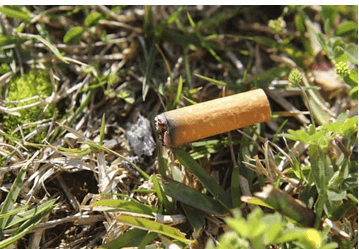
Causes of Soil Pollution
- Soil pollution is a complex occurrence, and it can be triggered by a variety of things and activities, from the littering of cigarette butts to excess use of chemical fertilizers.
- Every cause is linked with another. It is quite difficult to pinpoint one particular cause. However, the leading causes are listed below.
- Industrial Activity - Industrial activity has been the biggest contributor to the problem of soil pollution, especially since the amount of mining and manufacturing has increased. Most industries are dependent on extracting minerals from the earth. As a result, the industrial waste lingers on the soil surface for a long time and makes it unsuitable for use.
- Agricultural Activities - The utilization of chemicals has gone up tremendously since technology has provided us with modern pesticides and fertilizers. They are full of chemicals that are not produced in nature and cannot be broken down by it. As a result, they seep into the ground after they mix with water and slowly reduce the fertility of the soil.
- Waste Disposal - While industrial waste is sure to cause contamination, there is another way in which we are adding to the pollution. Every person excretes a certain amount of personal waste in the form of urine and feces. While much of it moves into the sewer system, there is also a large amount that is dumped directly into landfills in the form of diapers. Even the sewer system ends at the landfill, where the biological waste pollutes the soil and water.
- Accidental Oil Spills - Oil leaks can happen during the storage and transport of chemicals. This can be seen at most of the fuel stations. The chemicals present in the fuel reduces the quality of soil and make it unsuitable for cultivation. These chemicals can enter into the groundwater through the soil and make the water undrinkable.
- Acid Rain - Acid rain is caused when pollutants present in the air mix up with the rain and fall back on the ground. The polluted water could dissolve away some of the essential nutrients found in the soil and change the structure of the soil.
Effects Of Soil Pollution
Soil influences almost all aspects of our daily lives. Sometimes we fail to understand it. As a result of this, we sometimes fail to understand the effect that soil pollution has on our daily lives. Polluted soil means stunted crops or even a toxic underground water table. Some major effects of soil pollution are:
- Effect on Health of Humans - Considering how soil is the reason we are able to sustain ourselves, the contamination of it has major consequences for our health. Crops and plants that are grown on polluted soil absorb much of the pollution and then pass it on to us. This could explain the sudden increase in small and terminal illnesses. The soil pollution can even lead to widespread famines if the plants are unable to grow in it.
- Effect on Growth of Plants - The ecological balance of any system is affected due to the widespread contamination of the soil. Most plants are unable to adapt when the chemistry of the soil changes so radically in a short period of time. Fungi and bacteria found in the soil that bind it together begin to decline, which creates an additional problem of soil erosion.
The fertility of the soil slowly diminishes, making land unsuitable for agriculture and any local vegetation to survive. The soil pollution causes large tracts of land to become hazardous to health. Unlike deserts, which are suitable for their native vegetation, such land cannot support most forms of life. - Decreased Soil Fertility - The toxic chemicals present in the soil can decrease soil fertility and therefore decrease the soil yield. The contaminated soil is then used to produce fruits and vegetables, which lack quality nutrients and may contain some poisonous substances to cause serious health problems in people consuming them.
- Poisoning of the Underground Water Table - Soil pollution also leads to the poisoning of the underground water table. Since this water is stored beneath the layers of the soil, the toxins in the soil could easily percolate slowly and steadily into the water table.
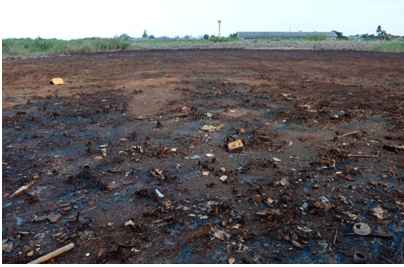
Possible Solutions to Soil Pollution
Soil pollution is a complex problem that ought to be solved. It is essential that we all realize how important soil is to us.
The earlier we realize this, the better we will be able to solve the problem of soil pollution. It is a complex problem, and thus, it requires everyone, from an individual to the government, to work in complete unison. Listed below are a few things that could help in reducing soil pollution.
- Reduced Use of Chemical Fertilizers - Chemical fertilizers do more harm than good. While proper amounts could enhance the fertility of the soil, an excess of it actually poisons the soil. The excess of chemical fertilizers could pollute the soil in several ways. It could mess with the pH levels of the soil. It could also destroy the good microorganisms in the soil. Not only that, but the runoff from such soils also causes water pollution as well. Thus, using chemical fertilizers is like a double-edged sword.
- Reforestation and Afforestation Should Be Promoted - One of the major causes of soil pollution is soil erosion, which is caused due to deforestation.
It is natural that, with an ever-growing population, humankind needs more and more space to expand their civilization. Often, it is achieved at the cost of the health of the soil.
To prevent this from happening, reforestation of a deforested area should be promoted. Also, afforestation should be promoted and encouraged in the barren lands.
The roots of the plants bind the soil particles together and even capture good microorganisms in the soil. It also ensures the maintenance of the underground water table. - Recycle and Reuse Products - These steps not only reduce waste generation but also ensure that soil pollution is reduced. At present, plastic forms a significant portion of the generated waste. More often than not, this wastes are buried in landfills.
In these landfills, these plastics and other materials decompose slowly and release toxic materials into the soil. These toxic substances are very harmful to the health of the soil and are a major source of soil pollution.
By reusing and recycling things, we would ensure that lesser wastes are dumped in these landfills, and this, in turn, would reduce soil pollution. - Promote Use of Natural Manure - Natural manure is one of the best sources of nutrients for the soil. It is harmless and completely organic. It adds essential nutrients to the soil and restores the health of the soil. It has no harmful by-products that could harm the soil or the environment in any way.
- Create awareness - In order to ensure that a problem like soil pollution is solved, it is essential that every individual must get involved. It is with their involvement that things can work out better. Awareness programs could be designed so that people understand soil pollution better. If people are aware, they will help, even subconsciously.
Safe Farming Practices That Prevent Soil Pollution
Different types of soil conservation methods ensure long-term usage of land and keep it productive for future generations. Let’s consider their benefits in regard to soil conservation.
- Conservation Tillage - The conservation tillage aims at addressing wind and water erosion by covering the earth with vegetation (either crops or their residues) and limiting the number of tilling operations. Another significant aspect is to choose the proper time for field operations, depending on the soil types. For example, clay ones are better to till after harvesting while other types are better to plow before seeding.
- Contour Farming - The soil conservation method proves efficient in slope territories and suggests planting species along the contour. Rows up and down the slope provoke soil erosion due to water currents while rows along the contour restrain it. An impact of terracing is similar: it also helps to conserve soil and reduce its degradation processes.
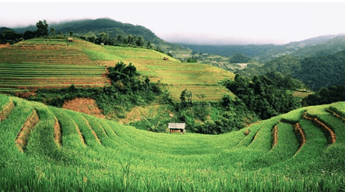
- Strip Cropping - In this case, farmers combine high-growing crops with low-growing ones for the sake of wind protection, like when corn grows in strips with forage crops. The strip cropping practice works even better when high-growing crops are intensified in the sides where winds blow most frequently. An extra benefit is the organic matter material from the low crops.
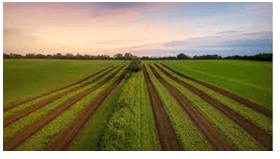
- Windbreaks - As the name suggests, this soil conservation practice is used to reduce the power of winds and its disruptive effect on soil. These are trees or bushes to shelter crops from snow and winds planted in several rows. Depending on the number of rows, we can distinguish windbreaks properly (up to five rows) and shelterbelts (six and more).
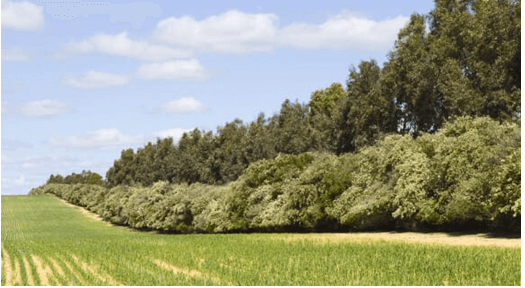
- Crop Rotation - Crop rotation vs. mono-cropping farming suggests changing agro species instead of planting one and the same for many subsequent seasons.
Farmers applying this soil conservation method reap numerous benefits. Crop rotation helps them improve the earth structure with diverse root systems, to mitigate pest establishments, and to add nitrogen to the land with legumes known as nitrogen-fixing plants. - Cover Crops - This soil conservation technique is another way to avoid bare soils and additionally benefit from planting cover crops – secondary species – in-between growing cash crops for different reasons like to:
- produce forage and grazing material for cattle;
- provide green manure;
- assist in weed control;
- retain moisture;
- ensure a natural environment for microorganisms and minor animals;
- balance nitrogen concentration (either releasing or accumulating it with certain plants).
- Buffer Strips - These are trees and bushes on the banks of water bodies to prevent sediment, water wash offs. Their roots fix the soil to avoid slumping and erosion, canopies protect from excessive sunlight to water inhabitants and falling leaves are a source of organic matter and food of minor aquatic animals
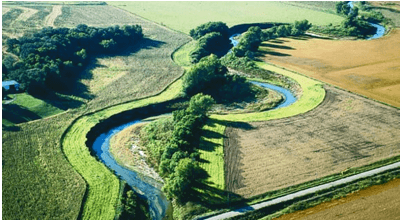
- Integrated Pest Management - Pests are a great nuisance to agriculturalists and have been a major issue to tackle while chemicals poison nature leaking to water and the atmosphere. It is important to eliminate synthetic herbicides replacing them with organic ones or establishing biological enemies of pests whenever possible, rotating crop species to minimize increasing pest populations in the same field for years, and using alternative techniques in complex.
Benefits of Soil Conservation
Humankind in general and farmers in particular benefit from numerous advantages of soil conservation. This agricultural practice contributes to sustainability in a number of ways:
- Boosts earth quality and productivity. Maintaining the natural environment for earth-dwelling organism’s increases fertility and reduces the necessity of chemical fertilizing, thus boosting yields and saving costs at the same time.
- Mitigates erosion. Soil conservation methods to reduce erosion and depletion help agriculturalists to avoid the expansion of new lands when territories become infertile.
- Promotes water infiltration and increases its storage. The soil conservation technique of minimum tillage vs. conventional plowing affects soil moisture by reducing cracking and evaporation as well as rising the infiltration rate.
- Aids air and water purification. The importance of soil conservation relates to water supplies, and the earth functions as a natural filter to purify water. Soil conservation mitigates the concentration of pollutants and sediments. In its turn, water is the basic condition to dissolve nutrients for plants. Soil carbon sequestration and reduced chemical applications contribute to air purity, too.
- Gives food and shelter for wildlife. Land with growing vegetation is a living environment for animals; it is not only the source for nourishment but their home as well.
“When the well is dry, we know the worth of water.”
– Benjamin Franklin, Poor Richard’s Almanack for 1733

Water Conservation Methods In Farming
- Mulch - We cannot overemphasize the importance of mulching. Mulch is something laid on the surface of the soil to protect the soil from the air, water and the sun.
To mulch, first weed the soil then spread a thick layer of organic mulch on the soil. Examples of organic mulches are:- Chopped leaves
- Straw
- Grass clippings
- Wood chips
- Shredded bark
- Pine needles
Mulching helps save time and labour as it discourages weeds and pests and conserve water through reduced evaporation.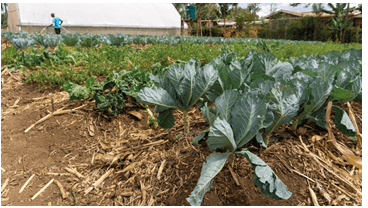
- Irrigate early morning or dusk - At the hottest and driest time of the year it is most efficient to water your crops in the morning or in the evening. This avoids water loss from evapotranspiration (water evaporating from the land and leaves of plants). Evaporation happens most in the midday sun.
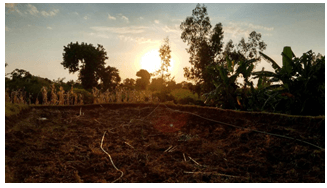
- Don’t over-water - It’s a common misconception that plants would be happy with lots of water all of the time. But often farmers are over-watering crops unnecessarily. Save water! Plants will only take what they need and then all that extra water goes to waste through evaporation, run-off or infiltration.
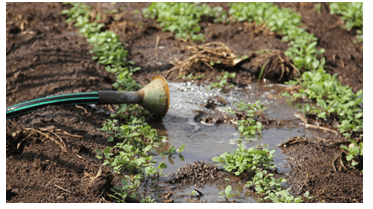
- Check for leaks and damage - If you’ve already invested in an irrigation system, make sure you’re not losing any water before it reaches the crops. Irrigation pipes and equipment can become damaged or blocked which causes leaks. Thoroughly check your equipment for leaks and repair them so that all the water you have gets to the crops.
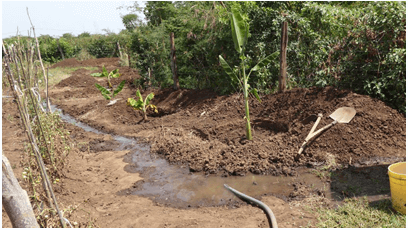
- Drip Irrigation - Drip irrigation systems deliver water directly to a plant’s roots, reducing the evaporation that happens with spray watering systems. Timers can be used to schedule watering for the cooler parts of the day, further reducing water loss.
Importance Of Water Conservation In Farming
- It minimizes the effects of drought and water shortages. By reducing the amount of water we use, we can better protect against future drought years.
- It helps to preserve our environment. Reducing our water usages reduces the energy required to process and deliver it to homes, businesses, farms, and communities, which, in turn, helps to reduce pollution and conserve fuel resources.
- It helps to preserve our environment. Reducing our water usages reduces the energy required to process and deliver it to homes, businesses, farms, and communities, which, in turn, helps to reduce pollution and conserve fuel resources.
Water Retention Structures To Conserve Surface Runoff
Water Retention Structures means a structure designed to retain a large volume of water
There are various methods of water retention to conserve surface runoff, this include:
- Water retention Ditches - Ditches are man-made waterbodies that are used mainly to drain the land.

- Earth Basins - is an area of land where all flowing surface water converges to a single point
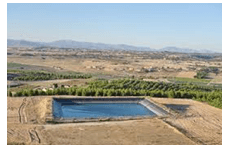
- Water retention pits – is an artificial pond with vegetation around the perimeter and a permanent pool of water in its design.

Minimum Tillage Practices That Conserve Water In Farming
Tillage practices refer to the tillage operations carried out between the harvest and following sowing/cultivation operation. Tillage, crop rotation and soil cover are practices related to pesticide and nutrient runoff, soil erosion, soil compaction etc. Some of the minimum tillage practices include:
- Use of herbicides;
- Uprooting/slashing;
- Use of cash crops;
- Limiting cultivation to the point planting;
- Proper timing of cultivation;
- Mulching
There are other different tillage practices distinguished are:
- Conservation tillage
- Conventional tillage
- Zero tillage
Conservation tillage can include the following systems:
- Strip tillage or zonal tillage refers to a system where strips 5 to 20 cm in width are prepared to receive the seed whilst the soil along the intervening bands is not disturbed and remains covered with residues. The system causes more soil disturbance and provides less cover along the rows than zero tillage.
- Tined tillage or vertical tillage refers to a system where the arable land is prepared with equipment which does not invert the soil and which cause little compaction. For this reason, the surface normally remains with a good cover of residues on the surface.
- Ridge tillage is a system of ridges and furrows. The ridges may be narrow or wide and the furrows can be parallel to the contour lines or constructed with a slight slope, depending on whether the objective is to conserve moisture or to drain excess moisture. The ridges can be semi-permanent or be constructed each year which will govern the amount of residue material that remains on the surface.
Conventional tillage
Refers to the arable land treated by conventional tillage which involves inversion of the soil, normally with a moldboard or a disc plough as the primary tillage operation, followed by secondary tillage with a disc harrow.
Zero tillage
Refers to the arable land on which no tillage is applied between harvest and sowing. Zero tillage is a minimum tillage practice in which the crop is sown directly into soil not tilled since the harvest of the previous crop. Weed control is achieved by the use of herbicides and/or appropriate mulching and stubble is retained for erosion control.

Agroforestry
It’s the cultivation and use of trees and shrubs with crops and livestock in agricultural systems.
Characteristics of Agroforestry
While selecting tree species for agroforestry systems, the following desirable characteristics should be taken into consideration. Though all desirable characters are not found in a single species, but their multiple uses are taken care of.
- Tree species selected should not interfere with soil moisture
- Tree species selected for agroforestry should have very less water requirement
- Should not compete with main agricultural crops for water.
- Tree species should be deep tap rooted so that they can draw water from deep strata of the soil.
- Tree species should not compete for plant nutrients
- Tree species should not utilize more plant nutrients
- They should help in building soil fertility,
- Leguminous tree species which fix atmospheric nitrogen in their roots should be prefered.
- The root system and root growth characteristics should ideally result in to exploration of soil layers that are different to those being trapped by agricultural crops.
- Tree species should not compete for sunlight
- Tree species should not interrupt sunlight falling on the crops.
- Tree species should be light branching in their habit.
- Trees permit the penetration of light into the ground and promote better crop, pasture growth and yield.
- Tree species can withstand pruning operation if it possess dense canopy.
- Tree species should have high survival rate and easy establishment
- Trees species should have high survival percentage,
- Leave little or no gaps after transplanting.
- Hardy tree species are easy to establish.
- They have less mortality percentage because they can tolerate transplanting shocks easily.
- Trees should have the ability to regenerate lateral roots within a short period of time after transplanting.
- Tree species should have fast growing habit and easy management
- Tree species for agroforestry system should be essentially fast growing,
- Rapid growth, especially in the early years,
- Tree should have short rotation (the period between planting and final harvesting)
- Fast growing species
- Tree species should have wider adaptability
- A tree species selected for agroforestry combinations must have a wider adaptability.
- Tree species should have high palatability as a fodder
- Most of the Indian farmer’s rear livestock separately and cut and carry method of fodder production is quite prevalent.
- Therefore, in agroforestry, farmer must select those tree species which are palatable to livestock and had a high digestibility.
- Tree species should have shelter conferring and soil stabilization attributes
- Some tree species, because of their inherent growth habit and adaptability, are especially helpful in providing protection for soils, crops and livestock.
- Tree species should have capability to withstand management practices
- Many agroforestry systems demand extensive pruning and lopping of the trees in order to maximize production. In such cases, the trees must be able to withstand such treatment without drastically restricting growth rate.
- Tree species should have nutrient cycling and nitrogen fixation attributes
- Within an agroforestry system, trees can play an important role in recycling nutrients, leached down through the soil profile and minerals released from weathering parent material such as rocks and sediments.
- These nutrients are used in the growth and development of the tree, many returning to the top-soil in form of dead leaves, twigs, flowers and seeds which slowly decompose on the surface, or are eaten by animals.
- Although all trees play some role in maintaining the nutrient status of the soil through recycling.
- Deciduous trees drop most of their leaves in autumn leaving a thick mat of leaves on the ground, whereas most evergreen species maintain some level of litter fall throughout the year.
- Another important factor is the ability of many tree species to convert atmospheric nitrogen into organic nitrogen for their own use through complex symbiotic relationship between Rhizobium bacteria and their fine roots.
- The bacteria form nodules on the roots which can convert nitrogen gas, as it is in the atmosphere, into usable nitrogen for the plant.
- The litter of these nitrogen fixing trees is generally high in nitrogen, thus increasing the nitrogen status of the soil.
- Tree species should have thin bark
- Species selected for agroforestry combinations should not shed its bark regularly but it should retain for longer period as bark shedding creates unhygienic conditions for under-ground crop.
- Tree species should be free from chemical exudations
- The species selected for agroforestry combination must be free from chemicals as these chemicals affect the growth of under-ground crops.
- Tree species should have easily decomposable leaves
- The suitable tree species for agroforestry will be that one in which fallen leaves decompose with fast rate.
- The leaves of most of the legume tree species are small in size, decompose quickly and easily, and add a large quantity of organic matter and nutrients to the soil.
- Tree species having broad leaves such as teak, mango and banyan should not be preferred for agroforestry system.
- They contain more fibre matter and also require longer time for decomposition. Further, broad leaves when fall on the tender crop plants, block their photosynthetic activities.
- Tree species should have their multiple uses
- The selected tree species should have multiple uses.
- The tree should yield more than one of the main produce like fuelwood, leaf fodder, edible fruit, edible flower and fibre.
- Tree species should have high yield potential
- High yield potential is the most important criterion of selection of tree species for agroforestry systems as the main aim is to obtain overall more output per unit area. Care should be taken before collection of seeds and seedlings that they are being procured from reliable source.
Suitable tree species for agroforestry
- Leucaena leucocephala
- Gravillea robusta
- Calliandra catothrysus
- Mangifera indica
- Sesbania sesban
- Lantana camara
- Cajanus cajan
Characteristics Of Agricultural Crops For Agroforestry
- Agricultural crops should be short duration and quick growing.
- They should be at least partially tolerant to shade.
- Most of them should belong to Leguminous family.
- They should respond well to high density tree planting.
- They should bear some adverse conditions, like water stress and/or excess of watering;
- Crops should return adequate organic matter to soil through their fallen leaves, root system, stumps, etc.
- Crops should appropriately be fitted in intensive or multiple cropping system.
Advantages/importance Of Agroforestry
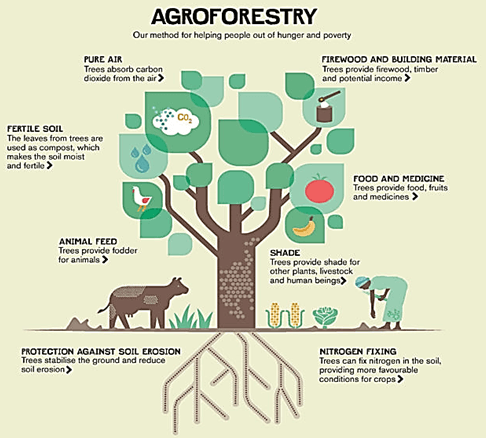
- Saves labour since some operations can be done at once for both plants and trees
- Gives higher combined yield
- Provide wide variety of agricultural produce
- Reduces the risks of total failure
- Crops benefit from nitrogen fixing trees.
- Trees help in holding the soil firmly
- Some trees act as livestock fodder.
- Provides a wider variety of agricultural produce.
Disadvantages of Agroforestry
- Mechanization is difficult.
- Use of pesticides and fertilizer may be difficult.
- Productivity may suffer because the skills for managing the different trees
Download Conserving Agricultural Environment - Grade 7 Agriculture Revision Notes.
Tap Here to Download for 30/-
Get on WhatsApp for 30/-
Why download?
- ✔ To read offline at any time.
- ✔ To Print at your convenience
- ✔ Share Easily with Friends / Students

